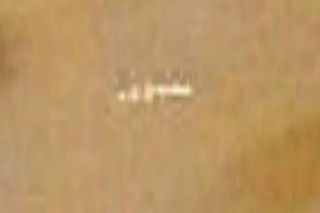Did an Amateur Astronomer Spot a Secret Mars Base?

A self-described "armchair astronaut" claims to have identified a human (or alien) base on Mars. David Martines noticed a mysterious rectangular structure that appears to be on the Red Planet's surface while trolling the planetary surface using Google Mars, a new map program created from compiled satellite images of the planet.
"This is a video of something I discovered on Google Mars quite by accident," said Martines, the armchair astronaut, in a now-viral YouTube video. "I call it Bio Station Alpha, because I'm just assuming that something lives in it or has lived in it."
He zooms in the surface anomaly — a long, pixelated, white object — and lists the coordinates as 49'19.73"N 29 33'06.53"W. "It's over 700 feet long and 150 feet wide. It looks like it's a cylinder or made up of cylinders," he says. [Watch the video]
Has Martines really found evidence of alien life, or a secret space base, as he and some media sources are claiming? No, say experts: "Bio Station Alpha" is simply a glitch in the image caused by cosmic energy interfering with the camera.
"It looks like a linear streak artifact produced by a cosmic ray," said Alfred McEwen, a planetary geologist at the Lunar and Planetary Lab at the University of Arizona and the director of the Planetary Imaging Research Laboratory. McEwen is the principal investigator of the High Resolution Imaging Science Experiment (HiRISE), a powerful telescope currently orbiting Mars.
Cosmic rays are extremely energetic particles emitted by the sun and other stars. For the most part, the Earth's protective magnetosphere blocks them from hitting the planet's surface, McEwen explained. "But with space images that are taken outside our magnetosphere, such as those taken by orbiting telescopes, it's very common to see these cosmic ray hits. You see them on optical images and a lot of the infrared images too," he told Life's Little Mysteries, a sister site to LiveScience.com. [Read: Why Do Photos from Deep Space Take So Long to Get to Earth?]
As a cosmic ray passes through a camera's image sensor, it deposits a large amount of its electric charge in the pixels that it penetrates. If the particle passes through at a shallow angle to the plane of the camera, it affects several pixels along its path. The result is a bright streak on the image.
Sign up for the Live Science daily newsletter now
Get the world’s most fascinating discoveries delivered straight to your inbox.
The digital compression software that converts the image into a JPEG file then "sort of smears out the image, giving it that pixelated look," McEwen said. What started as a clear streak in high-resolution turns into a streak that, in the armchair astronaut's words, looks like it is "made up of cylinders."
McEwen said that the cosmic ray streak would be much easier to recognize in the raw, pre-compressed image, but many orbiters and telescopes have contributed imagery to create the Mars map, and Google doesn't identify the source image.
"I can't tell whether this image was taken by Viking or what," McEwen said. "The people at Google need to document what the heck they're doing. They should be able to identify what the source of their information is, and let people know so they can go back and look at the raw data."
This article was provided by Life's Little Mysteries, a sister site to LiveScience. Follow Natalie Wolchover on Twitter @nattyover.
Natalie Wolchover was a staff writer for Live Science from 2010 to 2012 and is currently a senior physics writer and editor for Quanta Magazine. She holds a bachelor's degree in physics from Tufts University and has studied physics at the University of California, Berkeley. Along with the staff of Quanta, Wolchover won the 2022 Pulitzer Prize for explanatory writing for her work on the building of the James Webb Space Telescope. Her work has also appeared in the The Best American Science and Nature Writing and The Best Writing on Mathematics, Nature, The New Yorker and Popular Science. She was the 2016 winner of the Evert Clark/Seth Payne Award, an annual prize for young science journalists, as well as the winner of the 2017 Science Communication Award for the American Institute of Physics.
Most Popular


